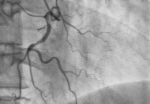In the last few years, we have seen significant growth of chronic total occlusion (CTO) percutaneous intervention, which has also been considered for patients with viable territory that remain symptomatic. Experienced centers present successful CTO intervention rates close to 90%, especially with a hybrid approach. However, it is still a complex procedure, and target vessel...
Coronary Bifurcation Lesions: MRS or PCI? 10-Year Mortality of the SYNTAX Study
Percutaneous treatment of coronary lesions affecting bifurcations has increased in recent decades. Coronary angioplasty (percutaneous coronary intervention, PCI) in these cases is associated with an increased rate of adverse events in patients with multivessel disease and left main coronary artery lesions. The SYNTAX score, which is a predictor of total mortality, is used to evaluate...
When is the Ideal Timing for NSTE-ACS Percutaneous Intervention?
According to the European Society of Cardiology (ESC Guidelines 2021) an early invasive strategy is recommended (<24h) for high-risk patients with acute coronary syndrome with no ST elevation (NSTE-ACS), namely patients presenting a rise or fall in cardiac troponin, dynamic ST- or T-wave changes and GRACE risk score >140. Early intervention (<2h) is reserved for...
Transfemoral vs Transradial Approach in the Percutaneous Treatment of CTO
Percutaneous treatment of chronic total occlusion (CTO) has traditionally been via the transfemoral approach (TFA). The use of the transradial approach (TRA) in complex coronary interventions has been increasing. A randomized study assessed the use of TRA vs TFA in complex PCI (58% CTO) and TRA saw favorable outcomes. The aim of this prospective, randomized,...
Coronary Angioplasty Evolution According to Syntax II: 5-Year Followup
It has been long since the SYNTAX (NEJM 2009) came out comparing percutaneous coronary intervention (PCI) against coronary artery bypass grafting (CABG). That emblematic study associated PCI with first generation drug eluting stents (Taxus) with increased major cardiac and cerebrovascular events (all-cause mortality, AMI, stroke, or any revascularization – MACCE) vs. CABG, at 5 years,...
Are There Differences Between Women and Men After a Percutaneous Intervention?
Prior research has shown that women with coronary artery disease who undergo percutaneous revascularization present more comorbidities, require less aggressive treatments, have greater long-term morbidity rates and worst functional status and/or post-procedure angina. This study used data from the CPORT-E trial (Cardiovascular Patient Outcomes Research Team Non primary Percutaneous Coronary Intervention) to assess baseline differences...
Acute Coronary Syndrome: What Is Safer, Antiaggregant Monotherapy or De-Escalation?
For several years it has been shown that 12-month dual antiplatelet therapy (DAPT) is mandatory for patients undergoing left main PCI for acute coronary syndrome (ACS). However, though this strategy does reduce thrombotic events and mortality, it also causes undesirable bleeding events followed by hospitalization and antiaggregation interruption for a period of time. A feasible...
IVUS in Acute Coronary Syndrome: A New Requirement?
The use of intravascular ultrasound (IVUS) has seen exponential growth across registries over the years, combined with mounting and increasingly robust evidence. The fact that it will enable us to characterize plaque morphology and extension prior the intervention, and even assess stent expansion post intervention, has turned it into a pillar of our efforts to...
AHA 2021 | Meta-Analysis of Surgery vs. Angioplasty in Left Main Coronary Artery Disease
According to this new meta-analysis (presented at AHA 2021 and published in The Lancet), mortality is similar between surgery and angioplasty to treat left main coronary artery in patients with simple or intermediate anatomy. This new study estimates that, after 5 years, mortality with surgery would be 11.2% vs. 10.2% with angioplasty, a non-significant difference. This debate...
The Most Read Articles in Interventional Cardiology during February
01- Efficacy of AstraZeneca’s Vaccine against COVID-19 This study, published in the Lancet, looks into the vaccine resulting from the collaboration of the Oxford University and AstraZeneca, among others. Read more HERE 02- Findings on Sputnik V Vaccine Against COVID-19 The Sputnik V vaccine was developed by Gamaleya NRCEM. Similarly to the Oxford-AstraZeneca vaccine, it is based on a viral vector,...









